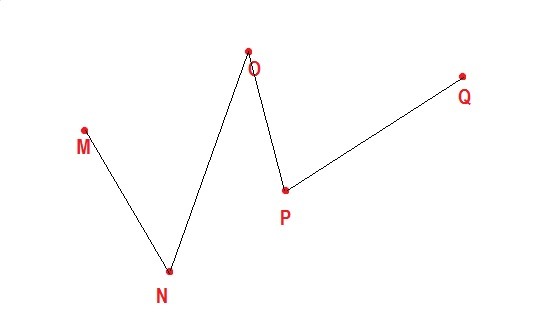Non-collinear points are a set of three or more points that do not fall on the same straight line. In other words, they are not in a straight line and cannot be connected by drawing a single straight line through all of them.
For example, imagine three dots randomly placed on a piece of paper. If you were to draw lines connecting each dot, you would notice that the lines intersect at different angles rather than forming one continuous straight line.
Understanding non-collinear points is important in geometry because it helps us identify shapes, such as triangles and polygons, which require at least three non-collinear points for their construction. Additionally, architects and engineers use this concept when designing structures to ensure stability and balance.
Non-Collinear Points Examples in Real Life
Here are some examples of non-collinear points in real life.
1. The Solar System
The Solar System refers to all the planets, moons, and other objects that orbit around the sun. These celestial bodies do not follow a straight line because they each have a unique path or orbit around the sun. This means that none of these objects are in direct line with one another since they move at different speeds and distances from the sun. For example, Earth orbits closer to the sun than Jupiter, so their paths never cross directly.
2. The Points on a Triangle
A triangle has three sides and three corners, which are called vertices. The points on a triangle, located at each vertex, cannot be in a straight line. This means that if you were to draw lines connecting any three of these points, they would never form a straight line. In other words, no matter how you connect the points on a triangle, you will always end up with an angled shape instead of a straight line.
3. The Pyramids of Giza
The Pyramids of Giza are three immense structures located in Egypt. They are not built in a straight line, meaning each pyramid stands on its spot and not on the same line as the other two pyramids. This makes them unique and exciting because they don’t follow a typical pattern or design.
4. The Olympic Rings
The Olympic rings are a symbol of the Olympic Games. They consist of five interlocking circles, each in different colors: blue, yellow, black, green, and red. The rings are arranged so no two rings pass through the same point in the center. All five points that make up the rings are evenly spaced apart.
5. The Lines on a Fingerprint
Fingerprints are unique to each person, and one reason is the lines on a fingerprint. These lines cross over each other at different angles, creating points that don’t line up in a straight line. This makes every fingerprint distinct and easily identifiable. Think of it like drawing a squiggly line versus a straight line – the squiggly line has more unique points where it changes direction, while the straight line only has two endpoints.
6. The Petals of a Flower
The petals of a flower grow from one point in the middle, but they don’t all line up perfectly on that same point. This means they don’t fall in a straight line. If you were to draw an imaginary line through each petal, it wouldn’t be a straight line like you might see on a ruler or piece of paper. Instead, it would curve and twist as it goes through each petal’s starting point.
7. The Chords on a Guitar
When you play the guitar, the points where you press down on the strings to make a chord are non-collinear. This means that if we were to draw lines between these points, no three of those lines would be in a straight line. When playing chords on a guitar, your fingers must always be pressing down on multiple strings simultaneously, not just one string in a row.
Also check: 11 Examples of Collinear Points In Real Life
8. The Waves in the Ocean
Waves in the ocean are like giant ripples on the water’s surface, and they can move in different directions. When two or more waves cross, they create points where they meet but don’t line up perfectly.
9. The Points on a Diamond
Diamonds have many flat surfaces called facets. These facets combine to form a unique pattern on the diamond’s surface. The interesting thing about these patterns is that they do not align with each other. This means that if you draw a straight line connecting two points on the diamond’s surface, it will not pass through any other point.
10. The Star Constellations
Although stars may appear in a straight line, they are located at different distances from Earth, which means they do not form a straight line when viewed from space. This concept is an example of non-collinear points because collinear points would be located on the same line, whereas these stars are not. Clearly, star constellations demonstrate how things can appear one way but be quite different upon closer examination.
11. The Points on a Soccer Ball
The black-and-white shapes do not form a straight line. They are arranged in a specific pattern, with each pentagon surrounded by five hexagons and each surrounded by three pentagons and three other hexagons.

